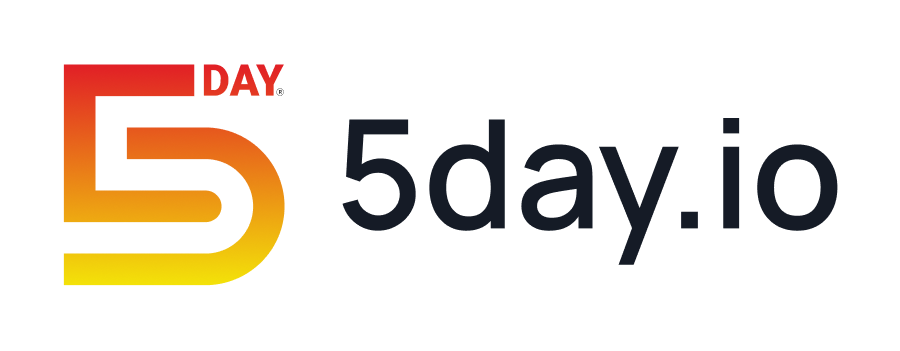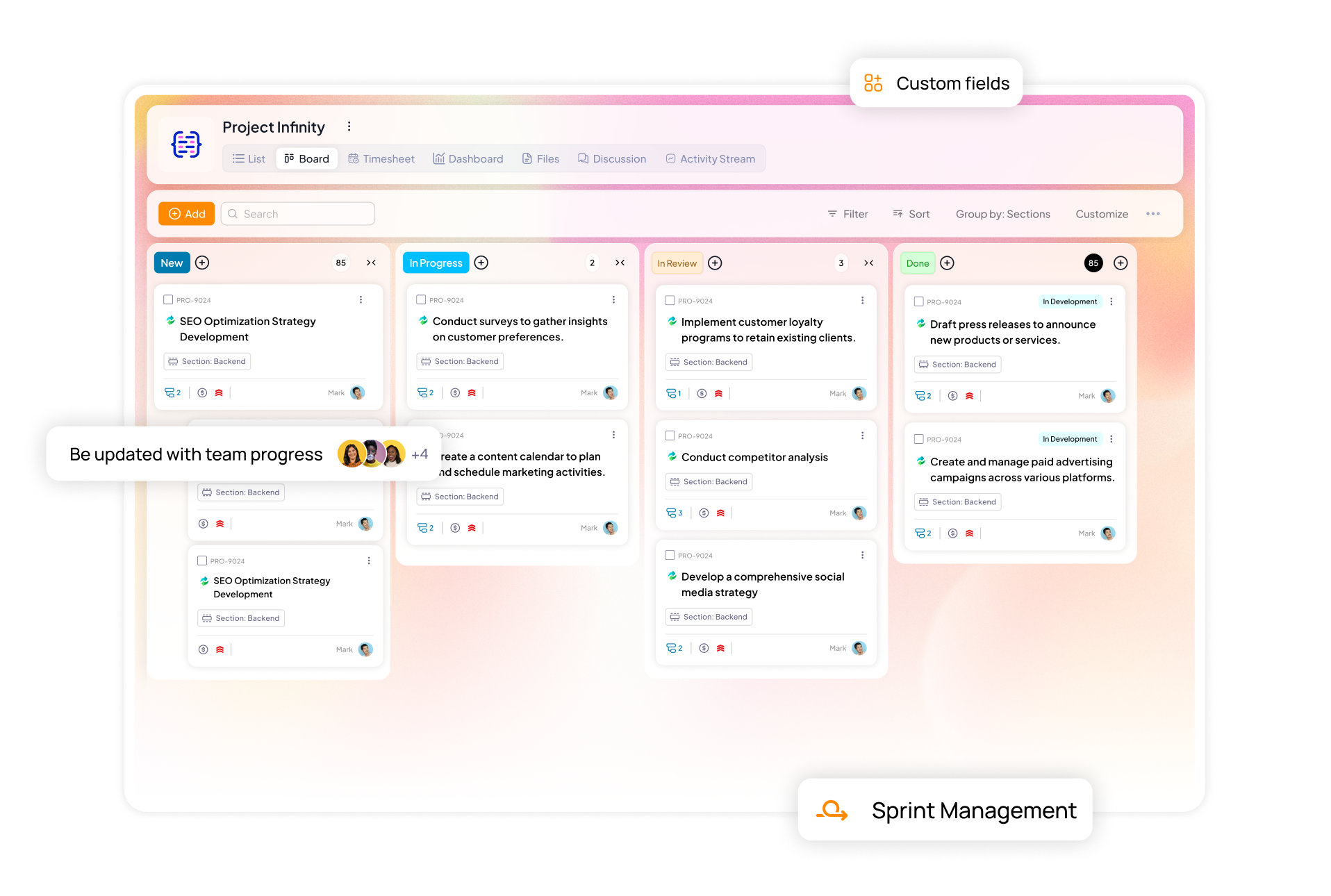Marketing teams are struggling fundamentally with how to get things done smoothly. That’s where project management methodologies come in.
The right one can make your life so much easier, but the wrong one can mess up your workflows and clog your productivity big time.
But here’s the catch. There’s no perfect system that works for everyone. What fits a scrappy 3-person team might feel like chaos for a 30-person marketing department.
That’s why in this guide, we’re breaking down the top methods marketing teams are using in 2025, how each one works, and when to use them.
Why marketing teams need a tailored project management methodology in 2025
If you’ve ever tried managing a go-to-market blitz using a rigid Waterfall chart, you know the pain. Traditional project management methodology was designed for engineering sprints and product pipelines. Definitely not the beautifully messy world of creative work.
A brilliant idea might be scrapped because of last-minute changes. A five-slide deck might spiral into a 30-email thread. Only when something like this happens do you realize how hard it is to get the entire team working on feedback in such a way that it doesn’t disturb other ongoing priorities.
This is why marketing teams need a tailored project management methodology that works in 2025, one that takes into account on-ground reality, and adapts quickly to shifting priorities.
Volatile mix of stakeholders
You’re managing a volatile mix of brand strategists, performance nerds, visual creatives, client-side marketers, freelancers, media buyers, and the one person who insists on using Excel for everything. Keeping everyone aligned is a herculean task, even with the most advanced software.
What works is having a framework to get through it all.
20 campaigns at once, with no clear finish line
In most jobs, when a task ends, it’s done. But in marketing, launching the campaign is just the midpoint. Then come the optimizations, and a whole series of steps that you need to take to meet the desired results. Just when you were neck-deep in the particular campaign, four new campaigns got briefed.
Speed vs. quality vs. sanity
You’re constantly caught between “We need this tomorrow” and “It has to be brilliant.” And while you’re juggling timelines, you’re also guarding your team’s mental health and energy levels like a hawk. When people are on the edge of burnout, they stop going above and beyond and start draining emotionally.
Tailoring your own project management methodology is crucial
Here’s what happens when your system is built for marketing instead of forced onto marketing:
You get flexibility without losing control
A tailored methodology bends when it needs to be done, without breaking. You can shuffle timelines and still hit the finish line because your structure was designed to be flexible.
You launch faster (without killing the idea in the process)
When the workflow reflects real creative energy, things move because you don’t have to do exhausting mental work just to track a task request. Everything flows in sync with how your team actually works.
Accountability without bureaucracy
Creative people hate feeling boxed in, but they thrive with clear roles and strong support. A tailored PM system offers structure to creative project management without suffocating people whose creative genius makes magic happen. This way, you’re not adding layers of approval. You’re only removing blockers.
Cross-team collaboration feels natural
When your project management methodology speaks the language of all your teams and honors their flow, something clicks. Handoffs become smoother, and nobody’s flow state feels forced. People start working with each other easily, with one central repository that holds all pertinent information together.
Top project management methodologies for marketing teams in 2025
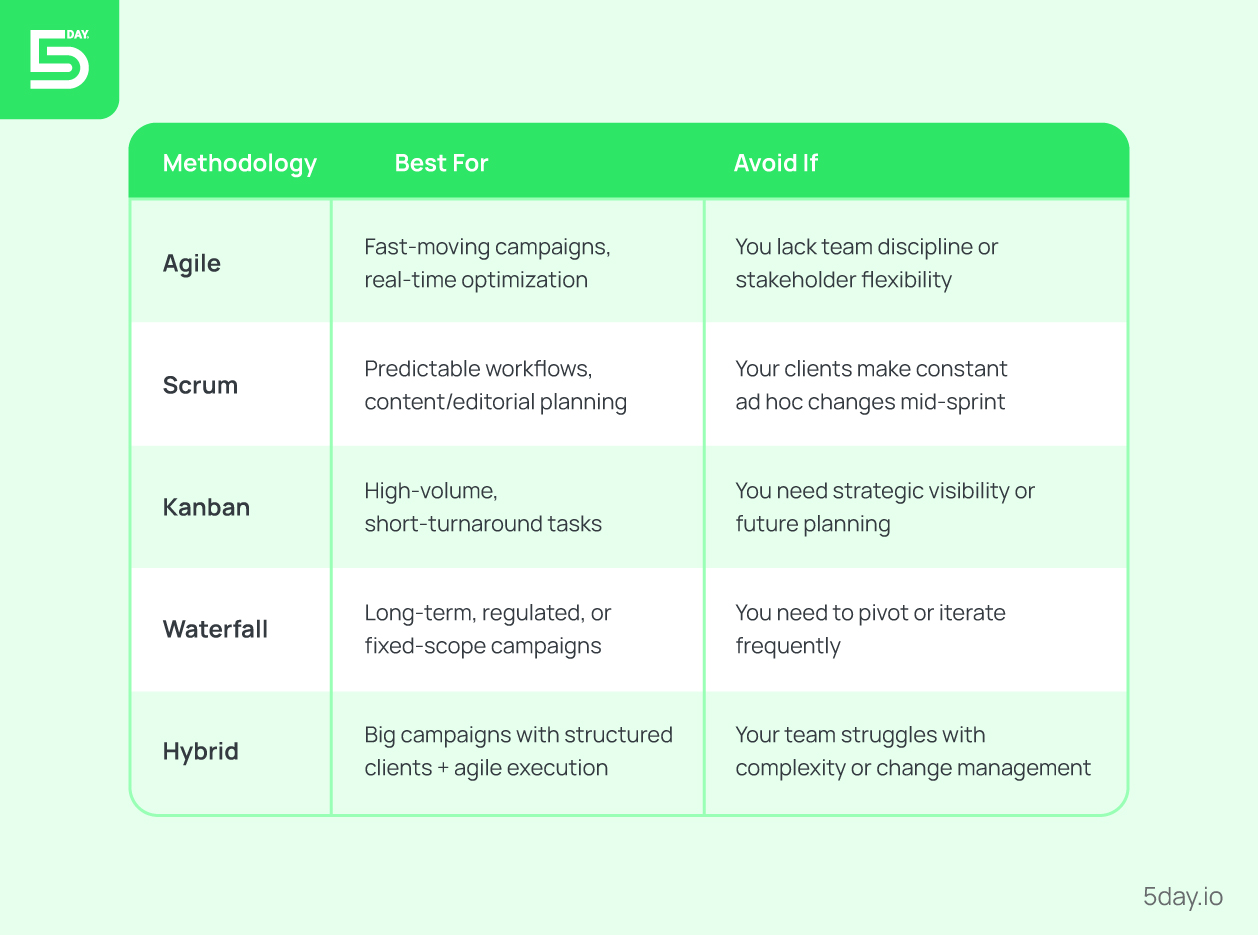
Agile
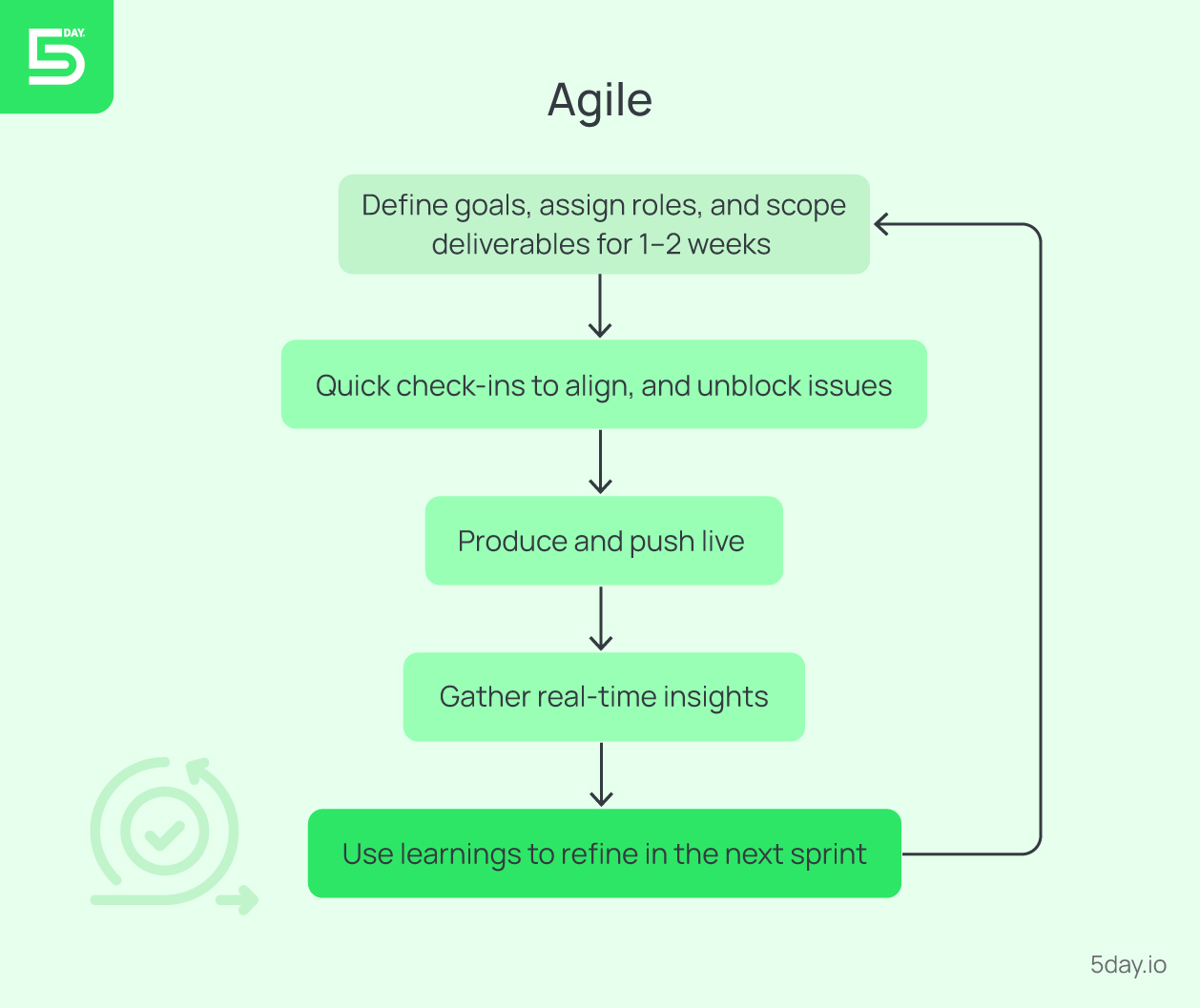
Agile, at its core, is a methodology built around rapid iteration. It emphasizes speed over perfection. While it originated in software development, Agile has found a natural home in marketing, where customer preferences and digital trends are prone to quick change.
For marketing teams, Agile project management methodology means launching campaigns or assets in smaller, manageable chunks called iterations or sprints. These sprints usually span one to two weeks and focus on producing working deliverables, whether that’s a paid ad set, a landing page, an email sequence, or influencer content.
Instead of planning everything in advance and hoping it works, teams release assets quickly and continuously improve.
Read Also: Take a Sneak Peek Into How the 5day.io Marketing Team Uses 5day.io
This iterative approach ensures marketing efforts stay responsive and relevant.
If early Instagram data reveals a more compelling visual hook, you don’t need to pause everything. Instead, you can adjust in the next sprint, using that insight to steer the campaign in a smarter direction. This way, it gives you leeway to let each channel evolve on its own.
Moreover, Agile encourages cross-functional teamwork. Instead of siloing your creatives or giving them input one after another, Agile brings them together in short daily standups to unblock issues and refine the project scope. This frequent, structured communication fosters a culture of ownership and prevents bottlenecks. This way, those handling dependent tasks know what’s coming, are prepared to go back and forth until the outcome is achieved. No one is overburdened, or is taken by surprise.
Read Also: Common Project Management Challenges and Solutions for Marketing Teams
For agencies, especially, this is invaluable.
Clients unfamiliar with Agile may struggle with the “build as you go” model, expecting polished perfection from day one. It also requires discipline to avoid scope creep and to pause regularly for retrospectives, critical moments of reflection that fuel growth.
Pros | Cons |
✅Lightning-fast campaign adjustments | ❌Doesn’t work well with clients who demand “sign-off” on every detail |
✅Increased team empowerment and morale | ❌ Needs high team discipline and strong prioritization |
✅ Stakeholders see progress every week—no mystery | ❌Can spiral into chaos without sprint boundaries |
Scrum
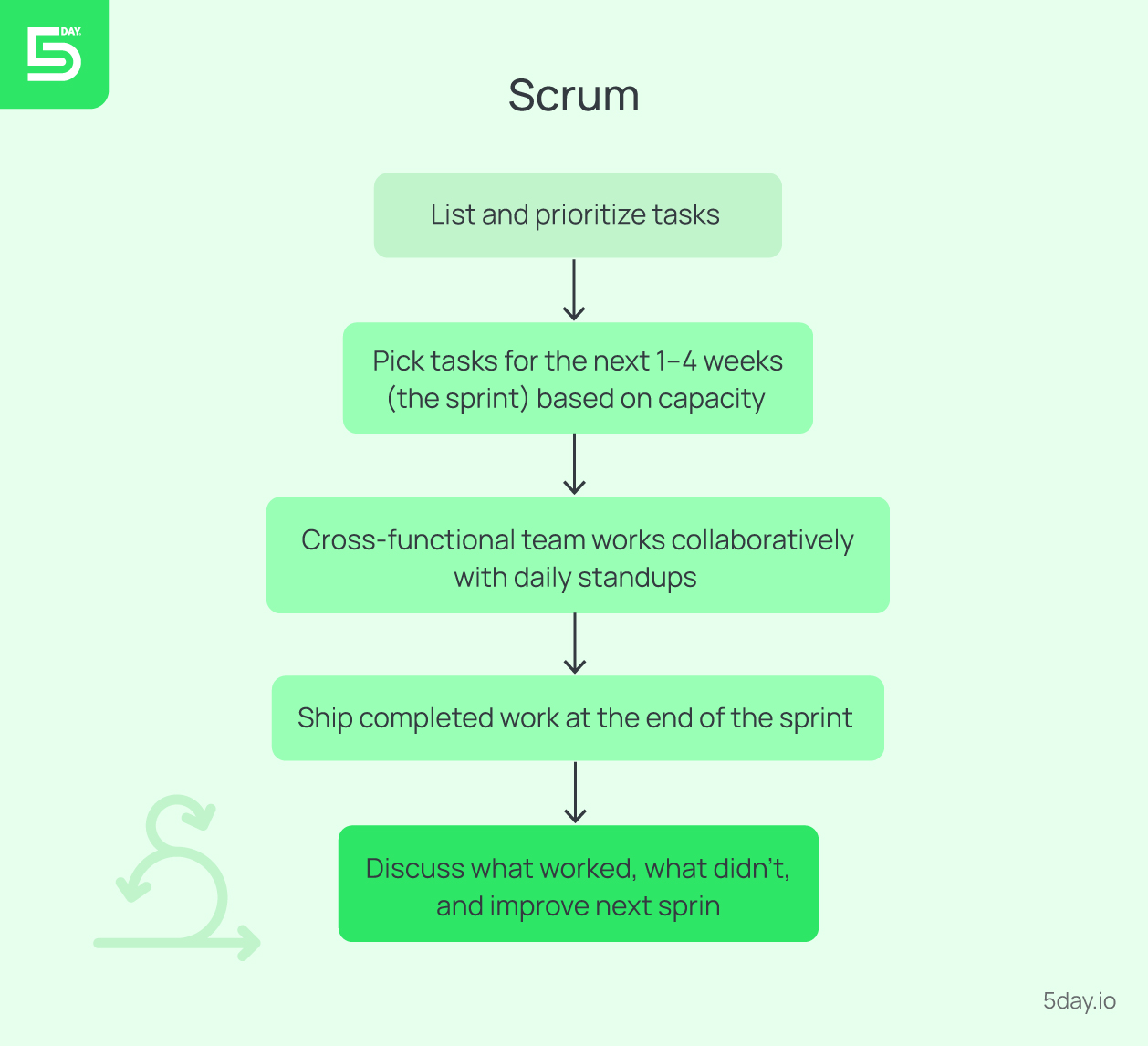
Scrum is one of the most structured implementations of Agile project management metholodogy, and it provides a reliable rhythm for marketing teams. While Agile is more of a mindset, Scrum is a tactical framework that operationalizes that mindset.
A Scrum-based team typically works in sprints of 1–4 weeks, during which they commit to completing a certain set of tasks. These tasks come from a product backlog, which is a living list of work items curated and prioritized by the Product Owner (often a marketing strategist or campaign manager in marketing contexts).
The Scrum Master, akin to a project lead, facilitates the process, ensuring the team is protected from distractions and roadblocks are swiftly removed. Then comes the Scrum Team: cross-functional players responsible for doing the actual work, design, copywriting, analysis, development, and more.
For marketing agencies, Scrum excels in recurring content production, or phased campaign execution.
Let’s say you’re managing content for a SaaS client: blog posts, newsletters, LinkedIn posts, gated whitepapers, and case studies. Each sprint could be dedicated to shipping a specific content batch, executed within a fixed period, and reviewed before moving to the next set. This approach promotes sustainable content velocity and continuous alignment between client needs and internal creative output.
The real strength of Scrum lies in its repeatable rhythm and process transparency.
Clients know what to expect every sprint. Internal teams know how much they can deliver without burning out. And retrospectives (held at the end of every sprint) help uncover bottlenecks and solve them collaboratively.
Teams that adopt Scrum often find their accountability strengthens.
Pros | Cons |
✅ Perfect for recurring, content-heavy projects | ❌ Not suited for sudden client interruptions or shifting strategies |
✅ Builds operational maturity | ❌ Requires a lot of discipline and clear role ownership |
✅ Clients see consistent velocity | ❌Teams new to Scrum may feel overburdened by ceremonies at first |
Kanban
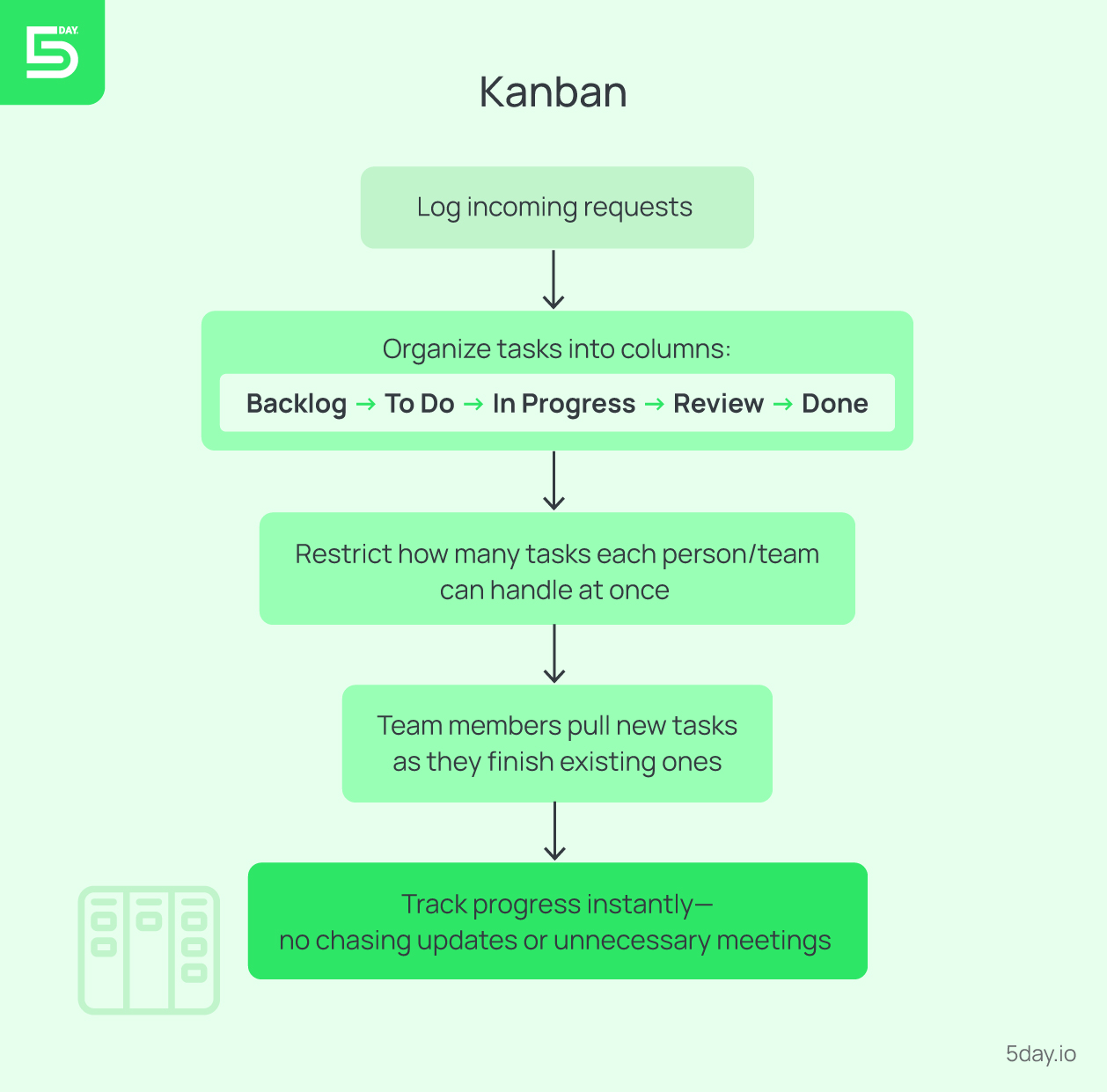
Kanban is a visual, flow-based project management methodology that focuses on managing tasks through a continuous delivery system. Unlike Agile or Scrum, Kanban doesn’t rely on sprints or time-boxed iterations. Instead, it organizes tasks on a board (digital or physical) into columns like: “Backlog,” “To Do,” “In Progress,” “Review,” and “Done.” The power of Kanban lies in its simplicity and focus on work in progress (WIP) limits.
Kanban is a favorite for marketing agency teams, design pods, ad ops teams, or any function that handles high-volume, reactive tasks. Think of a central creative services unit that gets multiple daily requests: landing page edits, banner ads, deck designs, email templates, or social graphics.
With Kanban, each request is logged, tracked, and moved across the board as it progresses. The team can instantly see what’s being worked on, what’s stuck in review, and what’s waiting.
One of Kanban’s key advantages is that it limits overload. You can restrict the number of items a person or team can work on at any given time (WIP limit).
This enforces focus, reduces multitasking, and accelerates throughput. The visibility Kanban provides is especially helpful for agency leaders and account managers; they don’t need to chase updates.
Kanban is also ideal for environments where deadlines are fluid and requests are ongoing, rather than batch delivered. It reduces the need for extensive planning meetings and empowers individuals to pull work when ready.
Pros | Cons |
✅Crystal-clear task status and ownership | ❌ Doesn’t offer future planning like Agile or Waterfall |
✅ Great for design, dev, or support teams in marketing | ❌ Team can lose momentum if requests aren’t prioritized |
✅ Minimal training needed | ❌ No natural sprint rhythm unless added manually |
Waterfall methodology
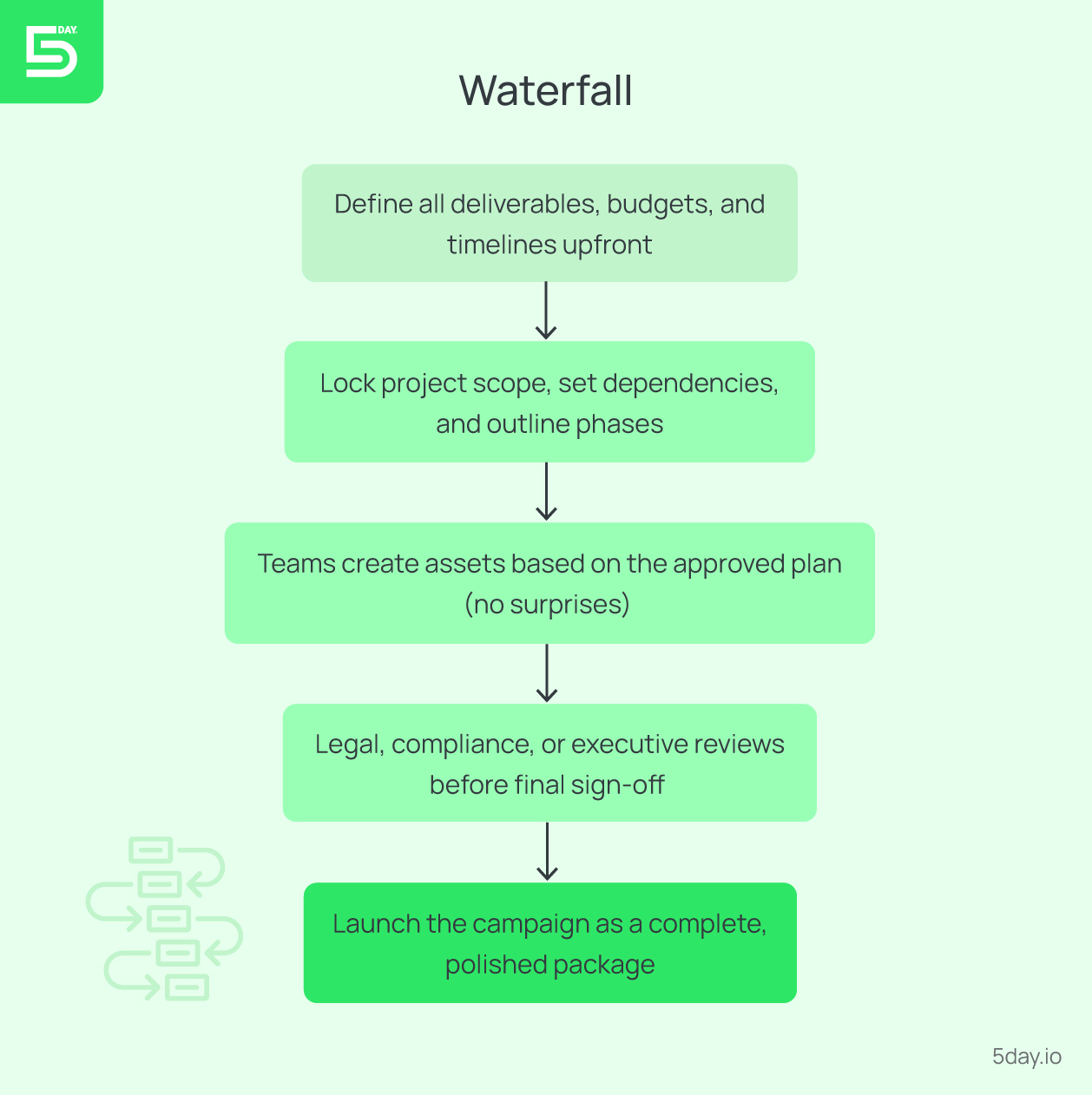 Waterfall is the traditional project management model, characterized by a strict, linear flow of project phases. Each stage must be completed before the next begins, such as requirements gathering, planning, execution, testing, and delivery.
Waterfall is the traditional project management model, characterized by a strict, linear flow of project phases. Each stage must be completed before the next begins, such as requirements gathering, planning, execution, testing, and delivery.
Once a phase is signed off, it’s considered locked.
Particularly in heavily regulated industries, large-scale brand campaigns, rebranding exercises, and anything involving legal, compliance, or executive review, Waterfall project management methodology provides the structure, and formality that Agile and Kanban can’t offer.
Read Also: Agile vs Waterfall
Let’s say your marketing agency is managing a 360° campaign for a multinational bank. The campaign involves:
- A flagship brand film
- Print ads for tier-1 newspapers
- OOH displays in three countries
- A tightly governed brand message
Here, every asset must pass through layers of legal approvals and translation checks. There’s little room for iteration after the campaign launches. In such cases, if you’re battling with Waterfall vs Agile methodology, Waterfall offers predictability.
Each phase has dedicated time, and responsibilities. The plan is clear from day one, and deviations are minimized. It also gives clients a sense of control, every stage has a review process, and nothing moves forward without approval.
However, Waterfall has major downsides in dynamic, performance-driven marketing. If you realize mid-way that your message isn’t landing, pivoting is hard.
Pros | Cons |
✅ Extremely predictable for large campaigns | ❌ No flexibility mid-stream |
✅ Ideal for compliance-heavy industries | ❌ One delay can block the entire timeline |
✅ Strong for cross-functional signoffs | ❌ Not suited for experimental or reactive campaigns |
Hybrid methodologies (Agile + Waterfall)
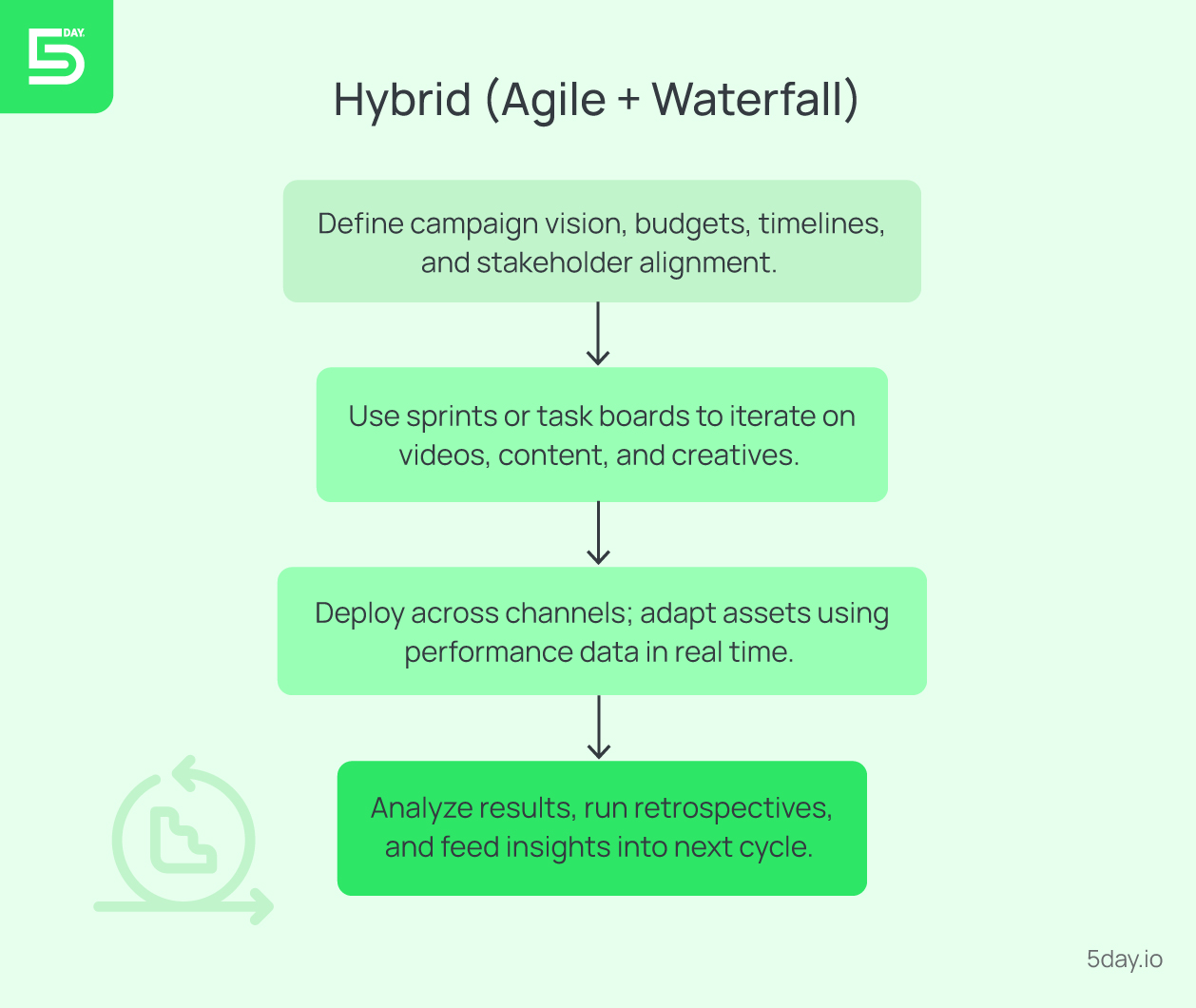
Also known as “Agile-Waterfall,” this approach allows marketing teams to plan strategically using Waterfall principles while executing flexibly using Agile sprints or Kanban flow.
For marketing agencies dealing with enterprise clients or large-scale product launches, hybrid is often the only viable option.
It satisfies the CMO’s need for structured planning, while giving the creative team freedom to iterate assets during rollout.
Say you’re managing a global campaign for a tech company launching a new line of smart devices.
- Phase 1 includes audience research, positioning, and stakeholder buy-in
- Phase 2 moves into asset production—videos, ad sets, content hubs
- Phase 3 is the actual rollout across 14 markets
In a hybrid model:
- Waterfall project management methodology governs the early stages, strategy, messaging framework, media plan, and brand guidelines
- Agile sprints or Kanban flow take over during production, teams iterate on landing pages, A/B test paid ads, localize email copy based on early engagement data
- Reporting and insights post-launch feed into retrospective sessions, informing the next cycle
Hybrid models require strong role clarity and segmentation of phases. Without clear definitions of where Agile starts and Waterfall ends, teams can get confused and project plans collapse.
It’s particularly valuable for large agencies, and cross-departmental initiatives involving creative and client-facing teams. Hybrid allows everyone to work in their natural mode.
Pros | Cons |
✅ Flexible yet structured—best of both worlds | ❌ Complex to manage if team lacks clarity |
✅ Tailored to clients with strict requirements | ❌ Needs mature project management culture |
✅ Allows scaling across large departments | ❌ Tools must support dual-mode workflows |
How to choose the right marketing team project management methodology
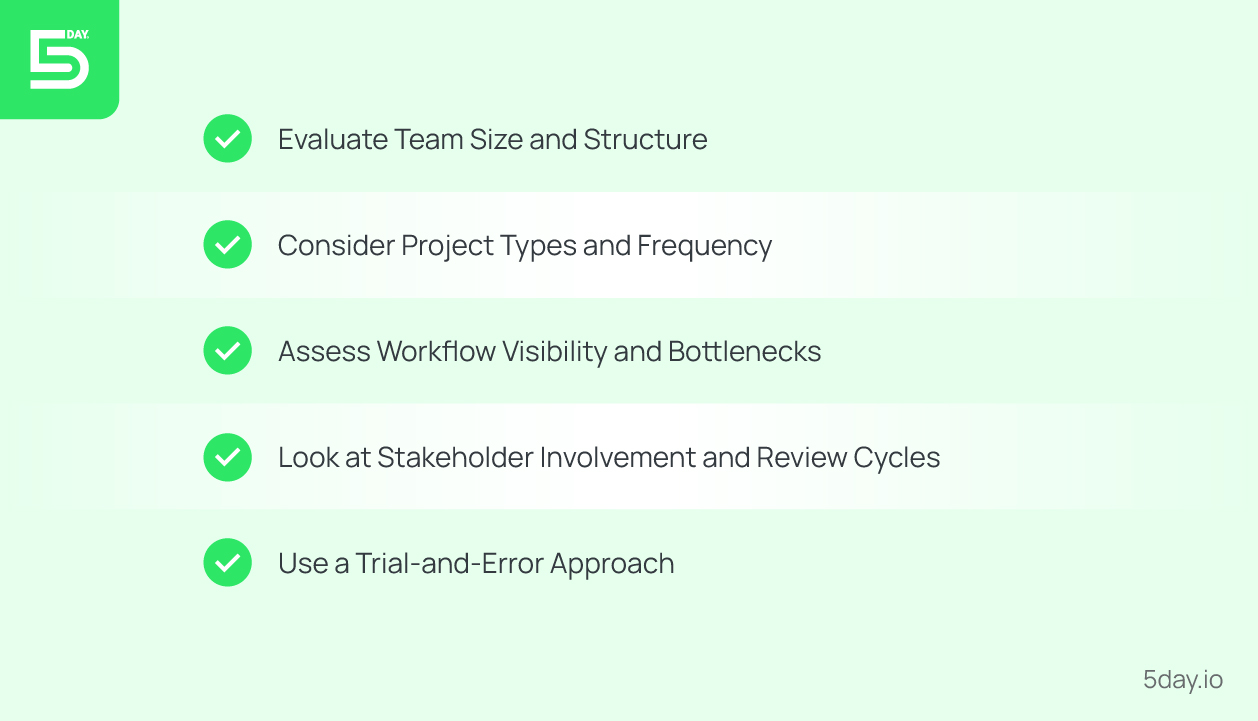
Evaluate team size and structure
The size, shape, and composition of your marketing team determine the level of process, and communication required to keep everything moving. A marketing project management methodology that works well for a lean startup creative team will likely break down into a 50-person global content operation, and vice versa. So based on your team size, the kind of methodology you need to unify them must be determined.
What to Look For:
Small teams (2–5 people):
These teams thrive in lightweight, flexible environments. Agile, Kanban, or even informal sprint models may be ideal here. Keep processes fluid, communicate through synchronous tools like Slack or daily huddles, and minimize documentation. Too much structure may feel like micromanagement.
Mid-sized teams (6–20 people):
Mid-sized teams need defined workflows, role clarity, and handoff processes across functions. Scrum or Hybrid Agile may offer the right balance.
Large teams (20+ people):
Here, complexity increases rapidly. You’ll likely need formal processes, cross-functional ceremonies, dashboards, and tools to coordinate efforts. Hybrid project management methodologies or structured Agile implementations may work best. Waterfall may also suit large brand projects that require strong oversight.
Consider project types and frequency
Your project management approach should reflect the cadence, predictability, and intensity of your work. Are you shipping daily content? Or producing a few blockbuster campaigns per year? The pace and pressure of your deliverables determine how much flexibility your system needs.
What to consider:
Recurring workflows (e.g., blogs, newsletters, ads):
These benefit from Scrum or Kanban. They allow you to build a delivery rhythm, track performance week-over-week, and make ongoing improvements.
One-time, large-scale campaigns (e.g., product launches, brand films):
These are often better suited to Waterfall or Hybrid methodologies, especially when working with external vendors, strict budgets, or legal oversight.
High-volume requests (e.g., creative service desks):
Kanban is perfect here. It allows tasks to flow freely based on capacity without complex planning cycles when it comes to project management for marketing teams.
Experimental or performance-driven campaigns:
Agile works best when the strategy is built around test-learn-adapt cycles. For example, optimizing paid ad sets based on conversion data each week.
Assess workflow visibility and bottlenecks
No methodology can succeed if your team doesn’t know who’s doing what, or what’s overdue. Poor visibility leads to missed deadlines, and burnout. A project management framework should give you real-time clarity without micromanaging you and the team.
Ask the following questions to gain better clarity:
- How transparent is your current workflow?
- Are tasks tracked and visible to everyone involved?
- Where do things typically get stuck, feedback, approvals, execution?
- Do team members frequently need to ask for updates, or is the status of work self-evident?
Based on your answers to the above questions, consider the following:
- Kanban for excellent visibility in creative services or execution-heavy teams. If you deal with dozens of small tasks, seeing them move across a board is a game-changer.
- Scrum for visibility through sprints, and daily stand-ups. You know what’s on deck, what’s mid-sprint, and what was completed.
- Waterfall for a high-level view through Gantt charts and structured milestone tracking, and is ideal when project dependencies matter in project management for marketing teams.
- Hybrid models often require the use of multi-layered dashboards and integrations across teams. You’ll need a tool stack that supports different layers of visibility, strategic planning vs. tactical execution.
Look at stakeholder involvement and review cycles
Clients, executives, compliance officers, brand teams, and legal departments all want a say, sometimes at the worst possible moment. The right methodology helps you build stakeholder feedback into the system, rather than treating it as an external force that alters work your team does.
What should you evaluate?
- How frequently do stakeholders give feedback?
- Are they available during sprints, or do they drop in randomly?
- Do you need formal approvals before moving forward?
- Is feedback subjective, or legally mandated?
Based on your answers to the above questions, consider the following:
- Agile and Scrum work best when stakeholders are involved frequently and can participate in sprint reviews
- Waterfall is suited for stakeholders who prefer fewer touchpoints but formal, milestone-driven updates
- Hybrid lets you split the difference, stakeholders approve the plan up front (Waterfall), then let the team execute and iterate (Agile)
Use a trial-and-error approach
No single methodology will be perfect from day one. The best agencies start with a framework, test it on live projects, and refine continuously. Your team’s DNA, client behavior, and creative style will shape the methodology over time.
How to pilot a new methodology
- Start small
Choose one project or one client team to test a new methodology. Don’t force a firm-wide rollout immediately.
- Define metrics for success
Track delivery times, client satisfaction, team morale, missed deadlines, review loop lengths.
- Hold retrospectives
What felt good? What broke? Where did the method help, and where did it restrict? Make a note of all these to revisit and learn.
- Iterate and evolve
Add your own internal rituals. Maybe you blend Scrum with Kanban. Maybe you use Waterfall for creative concepting and Agile for production. The goal is not to set a standard immediately, it’s to see which approach suits you the best, ensuring efficiency and sanity.
- Get team buy-in
The people doing the work should shape the system when it comes to project management for marketing teams. Hold alignment meetings. Share decision-making. Empower team leads to shape their own sub-methods.
How 5day.io supports different project management methodologies
Now that we’ve seen how different project management methodologies work in a marketing agency, let’s explore how 5day.io adapts to each framework.
Supporting Agile & Scrum methodologies for marketing
Marketing teams thrive on Agile’s iterative cycles and customer-first philosophy.
5day.io makes Agile implementation effortless by:
- Defining sprints with custom dates, track sprint progress, and view sprint-specific reports
- Creating task boards in “List” or “Board View” to mirror sprint backlogs and in-progress tasks
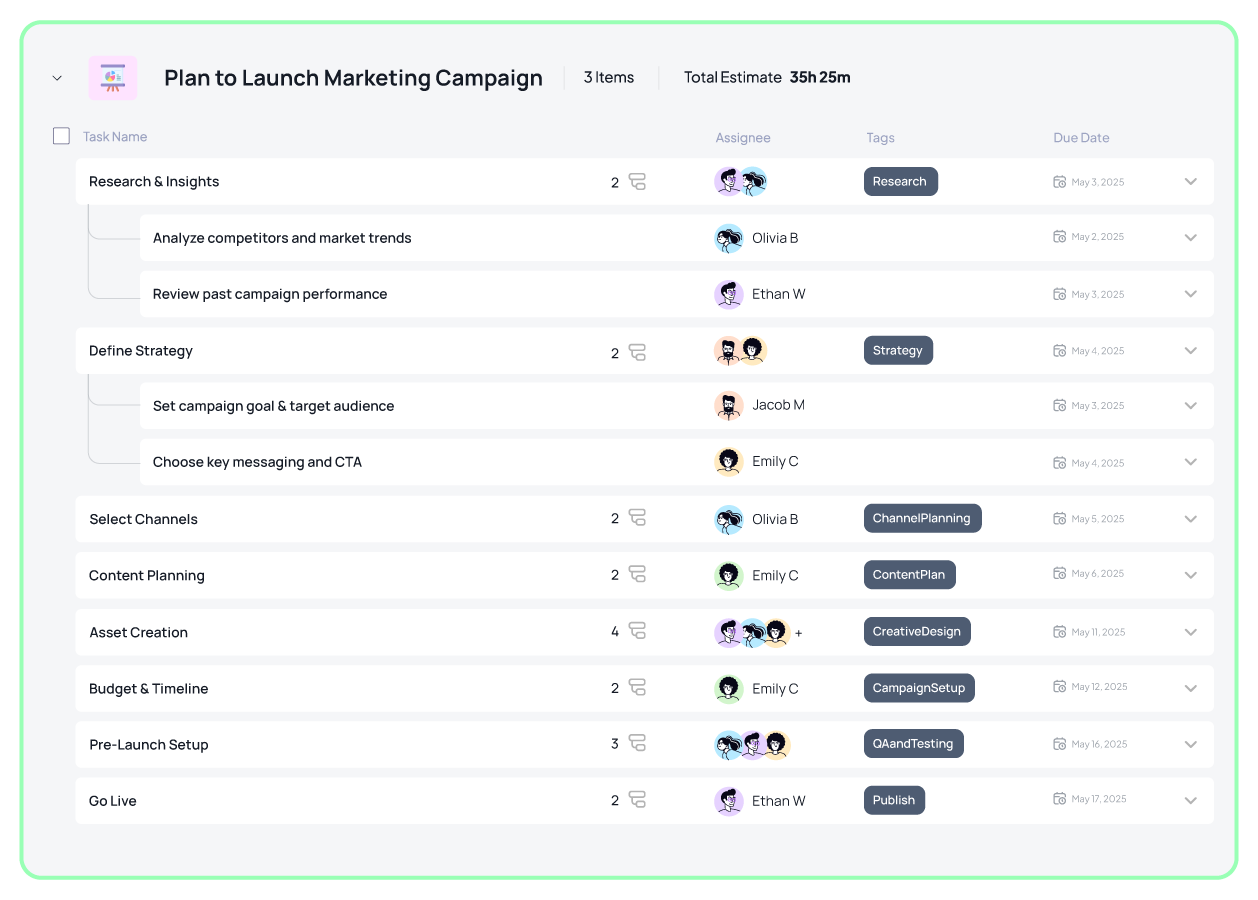
- Assigning effort via story points or time estimates per assignee, perfect for workload balancing
- Breaking larger campaigns into manageable tasks and subitems—ideal for sprint breakdowns
- Using Activity Stream and inline editing for real-time updates and stand-up readiness
Kanban board functionality
For teams that love to see the flow of work at a glance, Kanban is king. 5day.io empowers visual project management for marketing teams by:
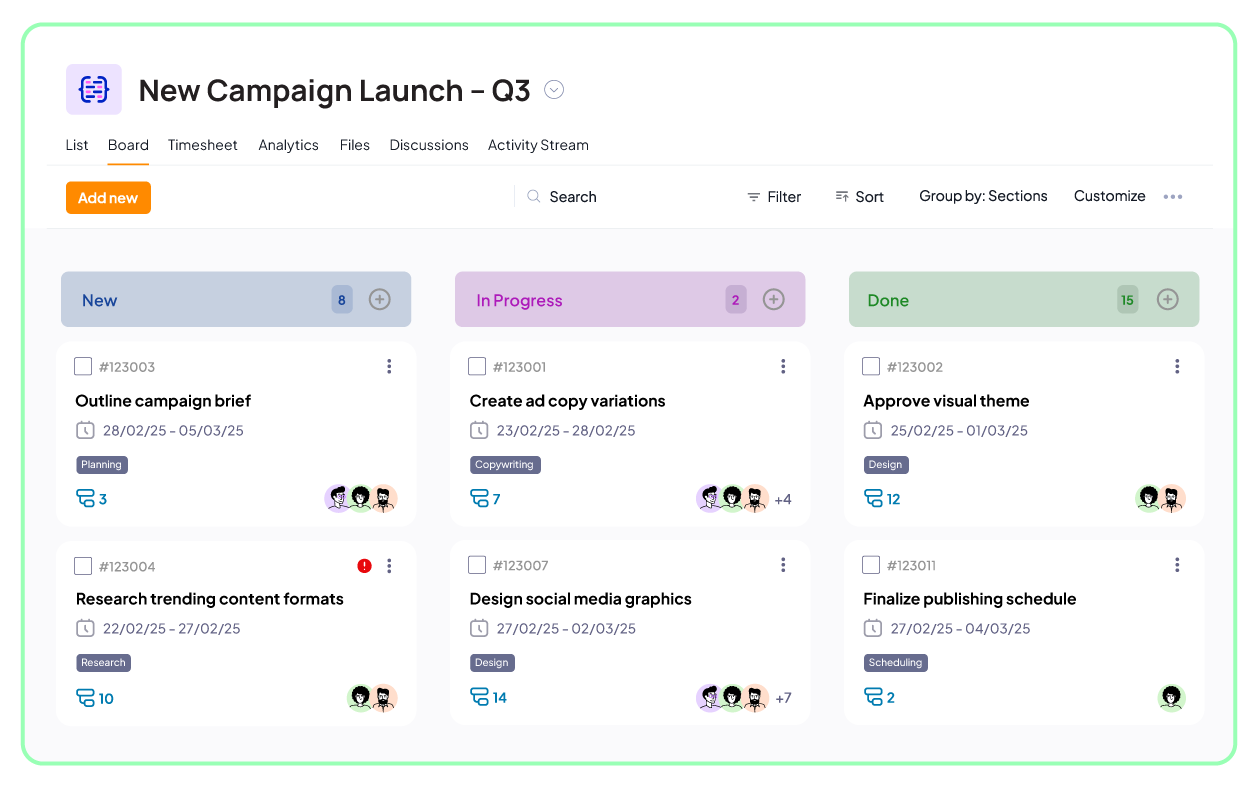
- Seamlessly moving tasks between statuses like “To Do,” “In Progress,” and “Ready for Review.”
- Customizing columns and status workflows to manage WIP limits and keep work moving
- Visually segmenting tasks by stage, urgency, or campaign type
- Track the progression of specific team workflows like tasks assigned to designers and their current status, or which stage content-related tasks are in
Whether you’re planning a social media calendar or tracking blog production pipelines, 5day.io makes Kanban intuitive and customizable.
Waterfall Project Structuring
Not all marketing projects are iterative. Some, like website redesigns, product launches, or trade show events require linear execution.
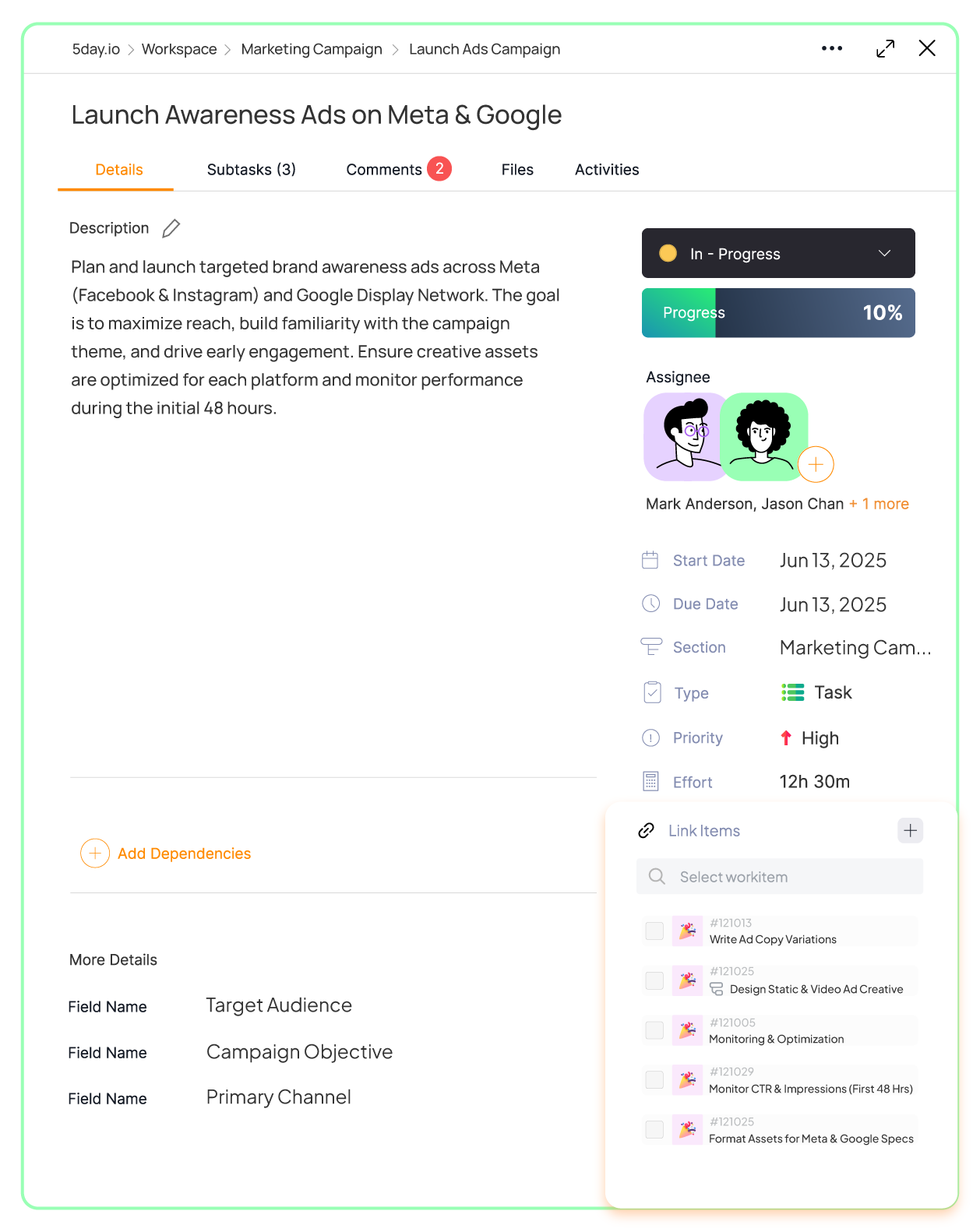
5day.io supports the Waterfall methodology by helping you:
- Visualize dependencies and fixed schedules clearly with the help of links, from kickoff to delivery
- Plan every phase in sequence, ensuring no task begins before its predecessor finishes
- View task completion in percentage, manually or automatically calculated from subitems
Waterfall-style execution is also ideal when working with clients who prefer predictability and documentation.
Hybrid Workflow Enablement
The reality is that most marketing teams use a hybrid methodology—structured planning upfront and execution similar to agile project management methodology during rollouts.
5day.io enables this with:
- Project templates for repeatable structures with which you can plan quarterly strategies and Agile sprints for weekly deliverables
- Multiple views on the same data so you can switch between list, board views based on team needs or project phase
- The ability to save and customize views so you can let each team member see work in a way that makes sense for them.
This level of adaptability makes 5day.io an ideal platform for workflows that keep growing and cross-functional collaboration.
What else do you get from using 5day.io?
- Whether your team is sprinting, flowing, or gating, everyone sees progress in real time, no fractured info silos
- Built-in comments, file sharing, and @mentions keep content, design, and performance teams in sync
- Know exactly what’s on deck, in progress, awaiting review, or delayed
- From product launches to content calendars, deploy repeatable frameworks in seconds
Sign up for 5day.io’s 30 days free trial today to get a good glimpse of the tool in action, and how you can tailor it to suit your own project management methodology.
